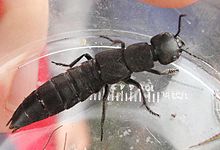- Devil's coach horse beetle
-
Devil's coach-horse beetle 
Scientific classification Kingdom: Animalia Phylum: Arthropoda Class: Insecta Order: Coleoptera Family: Staphylinidae Genus: Ocypus Species: O. olens Binomial name Ocypus olens
(O. F. Müller, 1764)Synonyms Staphylinus olens O. F. Müller, 1764
The Devil's coach-horse beetle (Ocypus olens) is a very common and widespread European beetle, belonging to the large family of the rove beetles (Staphylinidae).[1] It was originally included in the genus Staphylinus in 1764,[2] and some authors and biologists still use this classification. The species has also been introduced to the Americas and parts of Australasia.
This black beetle usually shelters during the day under stones, logs or leaf litter. It is most often seen in forests, parks and gardens between April and October.
Contents
Description
It is a long-bodied beetle. At about 25–28 millimetres (1.0–1.1 in) it is one of the larger British beetles. Its wing covers (elytra) are short covering only its thorax, exposing the abdominal segments. The abdominal musculature is powerful and the abdominal segments are covered with sclerotized plates. It is capable of flight but its wings are rarely used. It is covered with fine black hairs.
It is well known for its habit of raising its long and uncovered abdomen and opening its jaws,[1] rather like a scorpion when threatened. This explains one of its alternative names, the cock-tail beetle. Although it has no sting, it can give a painful bite with its strong pincer-like jaws. It also emits a foul smelling odour, as a defensive secretion, from a pair of white glands at the end of its abdomen.[1]
Diet
It is a predator, hunting mainly by night, feeding on invertebrates including worms and woodlice, as well as carrion. The prey is caught in the mandibles which are also used to cut and together with the front legs to manipulate the food into a bolus. The bolus is repeatedly chewed and swallowed, emerging covered with a brown secretion from the foregut, until it is reduced to a liquid which is digested. Skin (in the case of earth worms) and hard materials (from arthropods) are left. The larvae are also carnivorous with similar eating habits.
Reproduction
Females lay their eggs from 2-3 weeks after first mating. They are large (4 millimetres or 0.16 inches) and white with a darker band and laid singly in damp conditions under moss, stones, cow pats or leaf litter, typically in the Autumn. After around 30 days the eggs split and the larvae emerge, white with a straw coloured head. The larva lives largely underground, and feeds on similar prey to the adult and has the same well developed mandibles. It adopts the same display with open jaws and raised tail when threatened. The larva goes through three stages of growth (instars) the final stage ranging from 20 to 26 mm in length. At around 150 days the larva pupates for about 35 days and emerges as an adult with its final colouring, fully formed except for the wings which cannot be folded neatly beneath the elytra for several hours. Adults can survive a second winter, some by hibernating in burrows and not emerging until March while others remain active.
Superstition
This beetle has been associated with the Devil since the Middle Ages, hence its common name. Other names include Devil's footman, Devil's coachman and Devil's steed. In Irish, the beetle is called darbhdaol ("Devil's beast"); "it is said that the Devil assumes the form of this beetle to eat sinners".[1]
References
- ^ a b c d C. E. Nield (1976). "Aspects of the biology of Staphylinus olens (Müller), Britain's largest staphylinid beetle". Ecological Entomology 1 (2): 117–126. doi:10.1111/j.1365-2311.1976.tb01212.x.
- ^ Staphylinus olens, Fauna Europaea
Categories:- Staphylinidae
- Beetles of Europe
- Animals described in 1764
Wikimedia Foundation. 2010.




